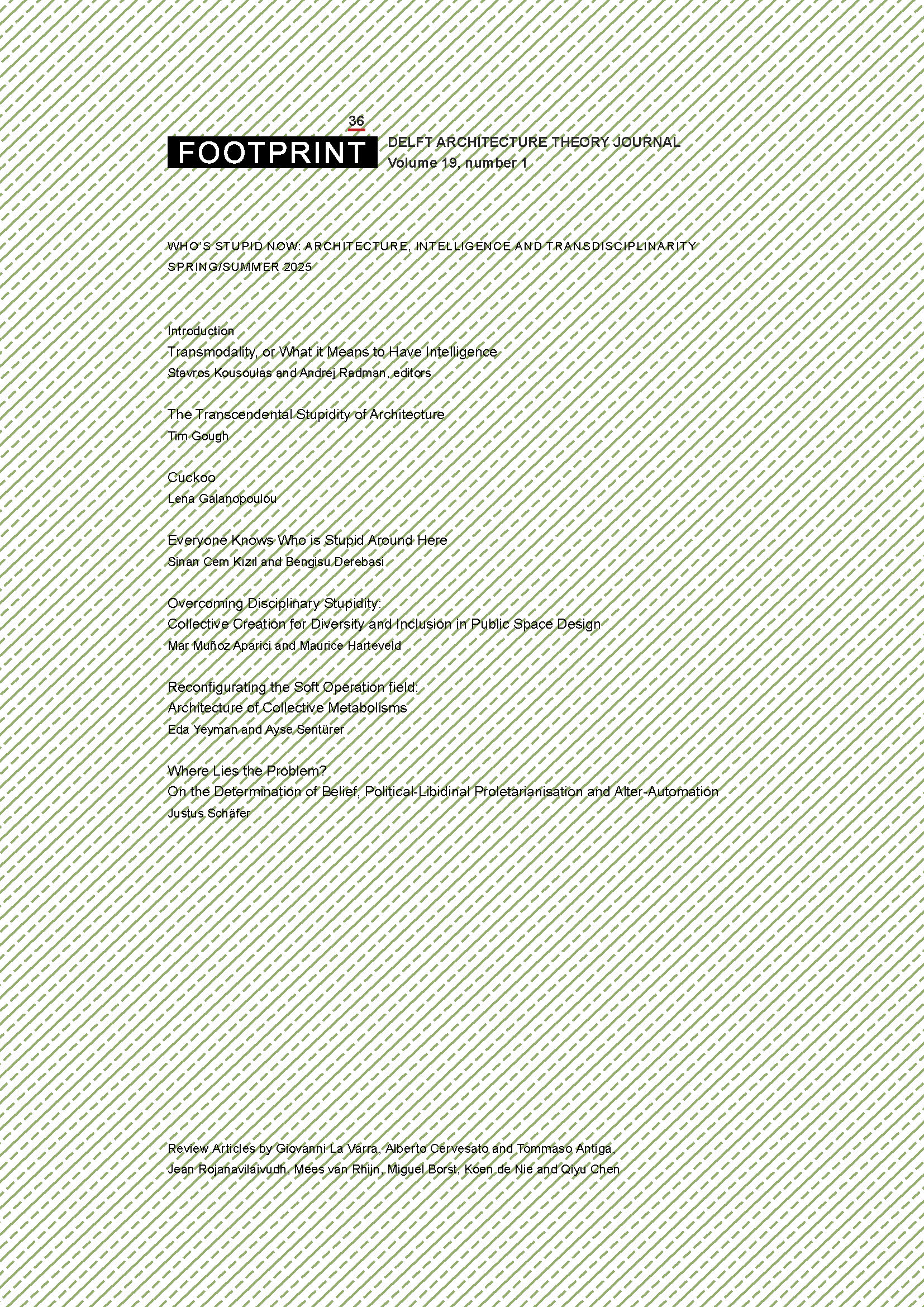Overcoming Disciplinary Stupidity
Collective Creation for Diversity and Inclusion in Public Space Design
DOI:
https://doi.org/10.59490/footprint.19.1.7490Abstract
This article explores the challenge of designing public spaces in hyperdiverse cities and argues that including knowledge often considered ‘stupid’ is key towards inclusive design approaches. It discusses recent shifts towards co-creation, co-design and placemaking by highlighting the importance of engaging with collective stupidity beyond presumed disciplinary intelligence. The integration of stupid or unconventional ideas in collective creation processes could help better problematise design challenges in public spaces and better engage with diverse perspectives to address diversity effectively. First, we will sketch the main societal pushes and academic turns supporting the enhancement of stupidity through the collective creation of public space for contemporary inclusive and hyperdiverse cities. Then, drawing on a comparative literature study of key authors introducing paradigmatic shifts for today’s theoretical framing and understanding of collective creation, diversity and design ethics in public space, we propose a non-conclusive series of design capacities for public space designers. These designer capacities are situated in contextual and sociocultural awareness, sensitivity to socio-spatial relations and narrative inquiry, and designing with the tacit, hence with empathy and responsibility. Finally, we highlight the relation between stupidity and failure in urban design and present relevant success practices. However complimentary to traditional design capacities, we conclude that these ethico-aesthetic approaches might challenge traditional notions of intelligence, beauty or authorship in design in favour of diversity and inclusivity.
References
Andersen, Lars Bo et al. ‘Participation as a Matter of Concern in Participatory Design.’ CoDesign 11, no. 3–4 (October 2, 2015): 250–61.
Antonini, Matteo. ‘An Overview of Co-Design: Advantages, Challenges and Perspectives of Users’ Involvement in the Design Process.’ Journal of Design Thinking 2, no. 1 (2021): 45–60.
Arespacochaga Maroto, Marina, Autoconstrucción, La Escuela Crece en la Biennale di Venezia (A Self Construction Project / Progetto di Autoconstruzione / Projet d’Autoconstruction) no. 1 (May 2016), https://theshowroom.org/media/pages/events/recetas-urbanas-data-sheets/0dede30ec4-1695373354/the_school_grows__madrid.pdf.
Arnstein, Sherry R. ‘A Ladder of Citizen Participation.’ AIP Journal 35 (1969): 216–25.
Barad, Karen. ‘Posthumanist Performativity: Toward an Understanding of How Matter Comes to Matter.’ Signs 28, no. 3 (Spring 2003): 801-831.
Barad, Karen. Meeting the Universe Halfway: Quantum Physics and the Entanglement of Matter and Meaning. London: Duke University Press, 2007.
Bennett, Jane. Vibrant Matter: A Political Ecology of Things. Durham: Duke University Press, 2010.
Boyer, Christine. Dreaming the Rational City: The Myth of American City Planning. Cambridge: MIT Press, 1993.
Bruyns, Gerhard, and Stavros Kousoulas. ‘An Introduction to Design Commons.’ In Design Commons, edited by Gerhard Bruyns and Stavros Kousoulas. Design Research Foundations. Cham: Springer International Publishing, 2022. https://doi.org/10.1007/978-3-030-95057-6_1.
Braidotti, Rosi. ‘Posthuman Critical Theory.’ Journal of Posthuman Studies 1, no. 1 (2017): 14.
Campbell, Heather. ‘‘Just Planning: The Art of Situated Ethical Judgment.’’ Journal of Planning Education and Research 26 (2006): 92–106.
Chiara Martinuzzi and Joy Mutai, 10 Years of Global Public Space Programme: Annual Report 2022 and Reflections on a Decade of Public Space (Nairobi: United Nations Human Settlements Programme (UN-Habitat), 2022).
Cirugeda, Santiago. 2015. Situaciones Urbanas. Barcelona, Spain: Editorial Tenov S.L.
Connor, Desmond M. ‘A New Ladder of Citizen Participation.’ National Civic Review 77, no. 3 (May/June 1988): 249-257.
Deleuze, Gilles. Différence and Répétition. Paris: Presses Universitaires de France, 1968.
Deleuze, Gilles, and Félix Guattari. Mille Plateaux. Paris: Les Éditions de Minuit, 1980.
Deleuze, Gilles. ‘From Realpolitik to Dingpolitik, or How to Make Things Public.’ In Making Things Public: Atmospheres of Democracy, edited by Bruno Latour and Peter Weibel, 14-45. Boston: The MIT Press, 2005.
Doucet, Isabelle, and Hélène Frichot. ‘Resist, Reclaim, Speculate: Situated Perspectives on Architecture and the City.’ Architectural Theory Review 22, no. 1 (January 2, 2018): 1. https://doi.org/10.1080/13264826.2018.1418127.
Evenson, Shelley. ‘Directed Storytelling - Interpreting Experience For Design.’ In Design Studies: Theory and Research in Graphic Design, edited by Audrey Bennett, New York: Princeton Architectural Press, 2006.
Foucault, Michel, Herbert Marcuse, Roel van Duyn, Henri Lefebvre, la CFDT, Jeannette Laot, Fredo Krumnow, Gilles Deleuze, Félix Guattari, Alain Touraine, and Charles Fourier. C’est Demain la Veille: Entretiens avec l’Actuel Nova. Paris: Éditions du Seuil, 1973.
Freire, Paulo. Pedagogy of the Oppressed. New York | London: Continuum, 1970.
Frichot, Hélène. ‘Foaming Relations: The Ethico-Aesthetics of Relationality.’ 2009.
Geertz, Clifford. ‘Making Experiences, Authoring Selves.’ In The Anthropology of Experience, edited by Victor W. Turner and Edward M. Bruner. Urbana: University of Illinois Press, 1986.
Gorny, Robert Alexander. ‘Reclaiming What Architecture Does: Toward an Ethology and Transformative Ethics of Material Arrangements.’ Architectural Theory Review 22, no. 2 (May 4, 2018): 188–209. https://doi.org/10.1080/13264826.2018.1481809.
Guattari, Félix. Chaosmose. Paris: Editions Galilee, 1992.
Guattari, Félix. The Three Ecologies. London; New York: Continuum, 2005.
Habitat III Policy Papers: Policy Paper 1 The Right to the City and Cities for All (New York: United Nations, 2017), www.habitat3.org
Hanappe, Cyrille, Beatrice Mariolle, and Cristiana Mazzoni. Ecologie Riveraine: La Seine-Saint-Denis à Horizon 2030. Paris: Éditeur La Commune, 2024
Haraway, Donna. ‘Situated Knowledges: The Science Question in Feminism and the Privilege of Partial Perspective.’ Feminist Studies 14, no. 3 (Autumn, 1988): 575-599.
Haraway, Donna. Staying with the Trouble: Making Kin in the Chthulucene. Durham, NC: Duke University Press, 2016.
Harteveld, Maurice. ‘Reviewing Premises on Public Spaces in Democratic, Inclusive, Agential Cities. Illustrated by Amsterdam.’ The Journal of Public Space 4, no. 2 (2019): 123-43.
Harvey, David. Rebel Cities: From the Right to the City to the Urban Revolution New York: Verso, 2019.
Harvey, David ‘The Right to the City’, International Journal of Urban and Regional Research 27, no. 4 (December 2003): 939–41, https://doi.org/10.1111/j.0309-1317.2003.00492.x
Hayden, Dolores. The Power of Place: Urban Landscapes as Public History. Cambridge: MIT Press, 1995.
Healey, Patsy. Collaborative Planning: Shaping Places in Fragmented Societies. London: Macmillan, 1997.
Healey, Patsy. ‘On Creating the ‘City’ as a Collective Resource.’ Urban Studies 39, no. 10 (September 2002): 1777-1792.
Hight, Christopher, and Chris Perry. ‘Collective Intelligence in Design.’ Architectural Design 76, no. 5 (September 2006): 5–9. https://doi.org/10.1002/ad.314.
Jan Liesegang, Markus Bader, Julia Klauer, Suzanne Labourie. Building the City Together. Berlin: ZK/U press, 2015
Kafka, George ‘Floating University in Berlin, Germany by Raumlabor’, The Architectural Review, 26 September 2022, https://www.architectural-review.com/buildings/floating-university-in-berlin-germany-by-raumlabor;
King, Stanley, Melinda Conley, Bill Latimer, and Drew Ferrari. Co-Design: A Process of Design Participation. New York: Van Nostrand Reinhold, 1989.
Landry, Charles. The Creative City: A Toolkit for Urban Innovators. London | Sterling: Comedia – Earthscan, 2000.
Latour, Bruno. Reassembling the Social: An Introduction to Actor-Network-Theory. 1st ed. in pbk. Clarendon Lectures in Management Studies. Oxford: Oxford Univ. Press, 2007.
Latour, Bruno. ‘Why Has Critique Run out of Steam? From Matters of Fact to Matters of Concern’ (Stanford Presidential lecture). Critical Inquiry 30 (Winter 2004), published in Chicago: The University of Chicago, April 7, 2003.
Latour, Bruno. From Realpolitik to Dingpolitik, or How to Make Things Public. In Making Things Public: Atmospheres of Democracy, edited by Bruno Latour and Peter Weibel, 14-45. Boston: The MIT Press, 2005.
Latour, Bruno, and Pierre Lemonnier (eds.). De la Préhistoire aux Missiles Balistiques: L’Intelligence Sociale des Techniques. Paris: La Découverte, 1994.
Levy, Pierre. L’Intelligence Collective: Pour une Anthropologie du Cyberspace (La Découverte Poche, Essais Volume 27). Paris: Éditions La Découverte, 1994.
Low, Setha ‘Embodied Space(s), Anthropological Theories of Body, Space, and Culture’, Space and Culture 6, no. 1 (2003).
Low, Setha M. ‘Toward an Anthropological Theory of Space and Place.’ Semiotica 175 (June 2009): 21-37.
Low, Setha. Spatializing Culture: The Ethnography of Space and Place. London | New York: Routledge, 2017.
Low, Setha, and Sally Merry. ‘Engaged Anthropology: Diversity and Dilemmas.’ Current Anthropology 51, no. 2 (2010): 203–226.
Low, Setha. ‘Claiming Space for Engaged Anthropology: Spatial Inequality and Social Exclusion.’ American Anthropologist 113, no. 3 (2011): 389–407.
Manzini, Ezio, and Rachel Coad. Design, When Everybody Designs : An Introduction to Design for Social Innovation. Cambridge, UNITED STATES: MIT Press, 2015. http://ebookcentral.proquest.com/lib/delft/detail.action?docID=3339947.
Mansbridge, Jane. ‘Everyday Talk in the Deliberative System.’ In Deliberative Politics: Essays on Democracy and Disagreement, edited by Stephen Macedo, 211-239. New York | Oxford: Oxford University Press, 1999.
Mattelmäki, Tuuli, and Froukje Sleeswijk Visser. ‘Interpretation Os Co-Design and Co-Creation.’ In Proceedings of IASDR’11, edited by Chen, Lin-Lin and Roozenburg, Norbert. 4th World Conference on Design Research, Delft University: International Association of Societies of Design Research (IASDR), 2011.
Mulgan, Geoff. Big Mind: How Collective Intelligence Can Change Our World. Princeton and Oxford: Princeton University Press, 2017.
Nathan, Max. The Economics of Super-diversity: Findings from British Cities, 2001-2006. Discussion Paper 68. London: SERC, 2011.
Normann, Richard, and Rafael Ramirez. Designing Interactive Strategy: From Value Chain to Value Constellation. Chichester | New York: John Wiley & Sons Ltd, 1998.
Orlikowski, Wanda J., and Susan V. Scott. ‘Exploring Material-Discursive Practices.’ Journal of Management Studies 52, no. 5 (2015): 697-705.
Petrescu , Doina, Helena Cermeño , Carsten Keller , Carola Moujan , Andrew Belfield , Florian Koch, Denise Goff , Meike Schalk , and Floris Bernhardt. ‘Sharing and Space‐Commoning Knowledge through Urban Living Labs across Different European Cities’. Urban Planning, 7, no. 3, 2022, pp. 254–273
Puig de la Bellacasa, María. Matters of Care: Speculative Ethics in More than Human Worlds. Posthumanities 41. Minneapolis: University of Minnesota Press, 2017.
Sanders, Elizabeth B.-N., and Pieter Jan Stappers. ‘Co-Creation and the New Landscapes of Design.’ CoDesign 4, no. 1 (March 2008): 5–18. https://doi.org/10.1080/15710880701875068.
Schrijver, Lara, ed. The Tacit Dimension. Leuven University Press, 2021. https://doi.org/10.11116/9789461663801.
Sohn, Heidi, Stavros Kousoulas, and Gerhard Bruyns. ‘Introduction: Commoning as Differentiated Publicness.’ FOOTPRINT, 2015.
Toffler, Alvin. The Third Wave. New York: William Morrow and Company, Inc., 1980.
Volont, Louis ‘Is Common Space Politically Potent? A Reflection on Raumlabor’s Aesthetic Gesture’, Forum+ 28, no. 1 (2021): 12–19
Wirth, Louis. ‘Urbanism as a Way of Life.’ American Journal of Sociology 44, no. 1 (1938): 1-24.
Downloads
Published
Issue
Section
License
Copyright (c) 2025 Mar Muñoz Aparici, Maurice Harteveld

This work is licensed under a Creative Commons Attribution 4.0 International License.
- Authors retain copyright and grant the journal right of first publication with the work simultaneously licensed under a Creative Commons Attribution License that allows others to share the work with an acknowledgement of the work's authorship and initial publication in this journal.
- Authors are able to enter into separate, additional contractual arrangements for the non-exclusive distribution of the journal's published version of the work (e.g., post it to an institutional repository or publish it in a book), with an acknowledgement of its initial publication in this journal.





